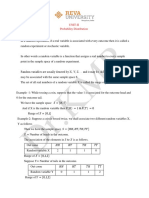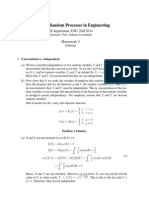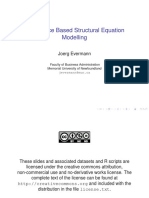Variance
Uploaded by
Shimaa MohammedVariance
Uploaded by
Shimaa MohammedVariance
The variance is a single-valued metric that reflects the amount of spread that the values
of a random variable will take on. More specifically, variance is the expected difference
between the random variable’s value and its mean (squared):
2
Var(X) ∶= E [ (X − E(X)) ]
(Definition 1). Variance can also be expressed as
Var(X) = E(X 2 ) − E(X)2
as proven in Theorem 1.
Intuition
The variance of a random variable is single number that tells us about the amount of
spread that we would expect to see if we were able to repeatedly sample from random
variable’s distribution. We note that the expectation of a random variable only tells
us the average value of the random variable over a long number of observations, but it
doesn’t tell us anything about how spread out we expect these values to be. For example,
let us define a random variable X where,
P(X = 0) = 0.5
P(X = 100) = 0.5
then,
E(X) = 50
If for another random variable,
P(Y = 50) = 1
then,
E(Y) = 50
Despite the fact that the two random variables behave very differently, they have the
same expected value. The expected value didn’t at all capture the fact that the values of
X are much more spread out than Y’s.
Properties
1. Variance of a scaled random variable:
Var(cX) = c2 Var(X)
where c is a constant (Theorem 2). Unlike expectation, variance is not a linear
function.
© Matthew Bernstein 2016 1
2. Variance of a shifted random variable: Given a random variable X and constant
c, the variance of X + c is simply the variance of X:
Var(X + c) = Var(X)
(Theorem 3). This result makes intuitive sense; since the variance measures the
amount of spread of the distribution, shifting the distribution left or right by a
constant doesn’t affect that spread and therefore shouldn’t affect the variance.
3. Variance of a point mass random variable: Given a random variable for which
X = c with probability 1, the variance of X is zero. Furthermore, if X is not
constant, then its variance is greater than zero (Theorem 4). This makes intuitive
sense, if a random variable will always be the same value, then there is zero spread
in the outcomes. On the other hand, if the random variable can take on more than
one value (even with small probability), the average spread will be non-zero.
4. Variance of convolution of random variables: Given two random variables X
and Y, variance of their sum is:
Var(X + Y) = Var(X) + Var(Y) + 2Cov(X, Y)
(Theorem 5). If, however, X and Y are independent, then we have
Var(X + Y) = Var(X) + Var(Y)
since the covariance of independent random variables is always zero.
Definition 1 Given random variable X with defined expected value, it’s variance is
given by
2
Var(X) ∶= E [ (X − E(X)) ]
Theorem 1
Var(X) = E(X 2 ) − E(X)2
© Matthew Bernstein 2016 2
Proof:
2
Var(X) = E [ (X − E(X)) ]
= E [(X − E(X))(X − E(X))]
= E [X 2 − 2XE(X) + E(X)2 ]
= E(X 2 ) − E[2XE(X)] + E[E(X)2 ]
= E(X 2 ) − 2E(X)E(X) + E(X)2
= E(X 2 ) − 2E(X)2 + E(X)2
= E(X 2 ) − E(X)2
Theorem 2
Var(cX) = c2 Var(X)
Proof:
Var(cX) = E [(cX)2 ] − E(cX)2
= c2 E (X 2 ) − c2 E(X)2
= c2 [E (X 2 ) − E(X)2 ]
= c2 Var(X)
Theorem 3
Var(X + c) = Var(X)
Proof:
Var(X + c) = E [(X + c)2 ] − E(X + c)2
= E (X 2 + 2cX + c2 ) − E(X + c)E(X + c)
Expanding the first term,
E (X 2 + 2cX + c2 ) = E (X 2 ) + 2cE(X) + c2
© Matthew Bernstein 2016 3
Expanding the second term,
E(X + c)E(X + c) = E(X)E(X + c) + E(c)E(X + c)
= E[XE(X) + cE(X)] + cE(X) + cE(c)
= E(X)2 + cE(X) + cE(X) + c2
= E(X)2 + 2cE(X) + c2
Putting it all together,
Var(X + c) = E (X 2 ) + 2cE(X) + c2 − E(X)2 − 2cE(X) − c2
= E (X 2 ) − E(X)2
= Var(X)
Theorem 4 If a random variable X is equal to a constant c, then
Var(X) = 0
Otherswise,
Var(X) ≥ 0
Proof:
The proof of this property lies in the fact that variance is equal to E [(X − E(X))2 ].
Not that if X = c, then the value inside the expectation is zero. Otherwise, the value
inside the exception is positive due to the squared.
Theorem 5
Var(X + Y) = Var(X) + Var(Y) + 2Cov(X, Y)
and
Var(X − Y) = Var(X) + Var(Y) − 2Cov(X, Y)
© Matthew Bernstein 2016 4
Proof:
We only prove the result for X + Y. The result for X − Y can be proven by
identical calculation by substitution −Y for Y.
Var(X + Y) = E [(X + Y)2 ] − E(X − Y)2
We see that the first term can be expressed as,
E [(X + Y)2 ] = E (X 2 + 2XY + Y 2 )
= E (X 2 ) + 2E(XY) + E (Y 2 )
The second term can be expressed as,
E(X + Y)2 = E(X + Y)E(X + Y)
= E(X)E(X + Y) + E(Y)E(X + Y)
= E[E(X)(X + Y)] + E[E(Y)(X + Y)]
= E[XE(X) + XE(Y)] + E[XE(Y) + Y E(Y)]
= E[XE(X)] + E[XE(Y)] + E[XE(Y)] + E[Y E(Y)]
= E(X)2 + E(X)E(Y) + E(X)E(Y) + E(Y)2
= E(X)2 + 2E(X)E(Y) + E(Y)2
Now putting it all together,
Var(X + Y) = E (X 2 ) + 2E(XY) + E (Y 2 ) − E(X)2 − 2E(X)E(Y) − E(Y)2
= E (X 2 ) − E(X)2 + E (Y 2 ) − E(Y)2 + 2[E(XY) − E(X)E(Y)]
= Var(X) + Var(Y) + 2Cov(X, Y)
© Matthew Bernstein 2016 5
You might also like
- Probability and Statistics: B Madhav Reddy Madhav.b@srmap - Edu.inNo ratings yetProbability and Statistics: B Madhav Reddy Madhav.b@srmap - Edu.in17 pages
- Variance and Standard Deviation Math 217 Probability and StatisticsNo ratings yetVariance and Standard Deviation Math 217 Probability and Statistics3 pages
- GROUP 17 Mercy K Expected Values, Covariance and CorrelationNo ratings yetGROUP 17 Mercy K Expected Values, Covariance and Correlation6 pages
- Caristi Fixedpoint Theorem Note and RemarquesNo ratings yetCaristi Fixedpoint Theorem Note and Remarques6 pages
- Conditional Expectations E (X - Y) As Random Variables: Sums of Random Number of Random Variables (Random Sums)No ratings yetConditional Expectations E (X - Y) As Random Variables: Sums of Random Number of Random Variables (Random Sums)2 pages
- Covariance - Correlation and Regression (Lecture)No ratings yetCovariance - Correlation and Regression (Lecture)11 pages
- 1 + X E (X Is Is Integrable, But Not Square Is Not Integrable, The Variance IsNo ratings yet1 + X E (X Is Is Integrable, But Not Square Is Not Integrable, The Variance Is18 pages
- Lecture 4 Inequalities and Asymptotic EstimatesNo ratings yetLecture 4 Inequalities and Asymptotic Estimates9 pages
- Vector Spaces N-Dimensional Euclidean SpaceNo ratings yetVector Spaces N-Dimensional Euclidean Space11 pages
- Statistics Boot Camp: X F X X E DX X XF X E Important Properties of The Expectations OperatorNo ratings yetStatistics Boot Camp: X F X X E DX X XF X E Important Properties of The Expectations Operator3 pages
- Information Theory: By: Prof. Mohamed Hamada Software Engineering Lab. The University of AizuNo ratings yetInformation Theory: By: Prof. Mohamed Hamada Software Engineering Lab. The University of Aizu32 pages
- Review Some Basic Statistical Concepts: TopicNo ratings yetReview Some Basic Statistical Concepts: Topic55 pages
- Introductory Probability and The Central Limit TheoremNo ratings yetIntroductory Probability and The Central Limit Theorem11 pages
- Some Fixed Point Theorems in Metric and 2-Metric Spaces: S. Venkata Ratnam NaiduNo ratings yetSome Fixed Point Theorems in Metric and 2-Metric Spaces: S. Venkata Ratnam Naidu12 pages
- Joint Distribution of Two Random VariablesNo ratings yetJoint Distribution of Two Random Variables5 pages
- Student's Solutions Manual and Supplementary Materials for Econometric Analysis of Cross Section and Panel Data, second editionFrom EverandStudent's Solutions Manual and Supplementary Materials for Econometric Analysis of Cross Section and Panel Data, second editionNo ratings yet
- Instructor s Solutions Manual for Probability and Statistics 4th Edition Morris H. Degroot - Download the full ebook version right now100% (1)Instructor s Solutions Manual for Probability and Statistics 4th Edition Morris H. Degroot - Download the full ebook version right now42 pages
- Final Exm Revew 2 Counting and ProbabilityNo ratings yetFinal Exm Revew 2 Counting and Probability18 pages
- Get (Ebook PDF) Understanding Business Statistics 1st Edition Free All Chapters100% (1)Get (Ebook PDF) Understanding Business Statistics 1st Edition Free All Chapters46 pages
- Corporate Finance 11th Edition Ross Solutions Manual100% (44)Corporate Finance 11th Edition Ross Solutions Manual17 pages
- Statistics and Probability Discrete and Continuous Random Variable 2No ratings yetStatistics and Probability Discrete and Continuous Random Variable 263 pages
- Tutorial Sheet #2: Random Variables and Probability Distributions Question: #1 Tutorial Day and Time: ThursadysNo ratings yetTutorial Sheet #2: Random Variables and Probability Distributions Question: #1 Tutorial Day and Time: Thursadys3 pages
- Avoiding Probabilistic Reasoning FallaciNo ratings yetAvoiding Probabilistic Reasoning Fallaci32 pages
- Course Title: Business Mathematics and Statistics MBA-1003 June 5 2010No ratings yetCourse Title: Business Mathematics and Statistics MBA-1003 June 5 201016 pages
- Basic Concepts of Probability: AID-521 Mathematics For Data ScienceNo ratings yetBasic Concepts of Probability: AID-521 Mathematics For Data Science16 pages
- Sheet 4: Conditional Probability, Bays FormulaNo ratings yetSheet 4: Conditional Probability, Bays Formula2 pages
- Core Concepts - Probability Booklet 2020-21No ratings yetCore Concepts - Probability Booklet 2020-2185 pages
- K12 Math Content Areas in Intermediate LevelNo ratings yetK12 Math Content Areas in Intermediate Level25 pages
- Aljassmi, H., & Han, S. (2013) - Analysis of Causes of Construction Defects Using Fault Trees and Risk Importance Measures.No ratings yetAljassmi, H., & Han, S. (2013) - Analysis of Causes of Construction Defects Using Fault Trees and Risk Importance Measures.11 pages
- Probability and Statistics: B Madhav Reddy Madhav.b@srmap - Edu.inProbability and Statistics: B Madhav Reddy Madhav.b@srmap - Edu.in
- Variance and Standard Deviation Math 217 Probability and StatisticsVariance and Standard Deviation Math 217 Probability and Statistics
- GROUP 17 Mercy K Expected Values, Covariance and CorrelationGROUP 17 Mercy K Expected Values, Covariance and Correlation
- Conditional Expectations E (X - Y) As Random Variables: Sums of Random Number of Random Variables (Random Sums)Conditional Expectations E (X - Y) As Random Variables: Sums of Random Number of Random Variables (Random Sums)
- 1 + X E (X Is Is Integrable, But Not Square Is Not Integrable, The Variance Is1 + X E (X Is Is Integrable, But Not Square Is Not Integrable, The Variance Is
- Statistics Boot Camp: X F X X E DX X XF X E Important Properties of The Expectations OperatorStatistics Boot Camp: X F X X E DX X XF X E Important Properties of The Expectations Operator
- Information Theory: By: Prof. Mohamed Hamada Software Engineering Lab. The University of AizuInformation Theory: By: Prof. Mohamed Hamada Software Engineering Lab. The University of Aizu
- Introductory Probability and The Central Limit TheoremIntroductory Probability and The Central Limit Theorem
- Some Fixed Point Theorems in Metric and 2-Metric Spaces: S. Venkata Ratnam NaiduSome Fixed Point Theorems in Metric and 2-Metric Spaces: S. Venkata Ratnam Naidu
- Student's Solutions Manual and Supplementary Materials for Econometric Analysis of Cross Section and Panel Data, second editionFrom EverandStudent's Solutions Manual and Supplementary Materials for Econometric Analysis of Cross Section and Panel Data, second edition
- Instructor s Solutions Manual for Probability and Statistics 4th Edition Morris H. Degroot - Download the full ebook version right nowInstructor s Solutions Manual for Probability and Statistics 4th Edition Morris H. Degroot - Download the full ebook version right now
- Get (Ebook PDF) Understanding Business Statistics 1st Edition Free All ChaptersGet (Ebook PDF) Understanding Business Statistics 1st Edition Free All Chapters
- Corporate Finance 11th Edition Ross Solutions ManualCorporate Finance 11th Edition Ross Solutions Manual
- Statistics and Probability Discrete and Continuous Random Variable 2Statistics and Probability Discrete and Continuous Random Variable 2
- Tutorial Sheet #2: Random Variables and Probability Distributions Question: #1 Tutorial Day and Time: ThursadysTutorial Sheet #2: Random Variables and Probability Distributions Question: #1 Tutorial Day and Time: Thursadys
- Course Title: Business Mathematics and Statistics MBA-1003 June 5 2010Course Title: Business Mathematics and Statistics MBA-1003 June 5 2010
- Basic Concepts of Probability: AID-521 Mathematics For Data ScienceBasic Concepts of Probability: AID-521 Mathematics For Data Science
- Aljassmi, H., & Han, S. (2013) - Analysis of Causes of Construction Defects Using Fault Trees and Risk Importance Measures.Aljassmi, H., & Han, S. (2013) - Analysis of Causes of Construction Defects Using Fault Trees and Risk Importance Measures.
























































































